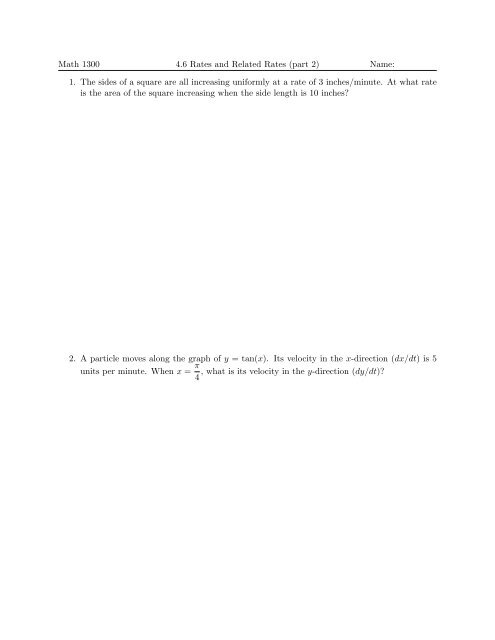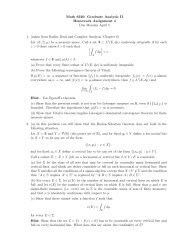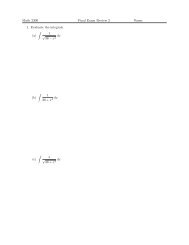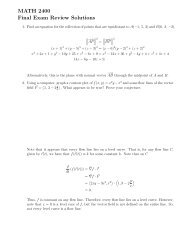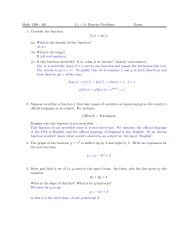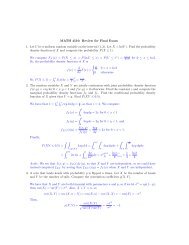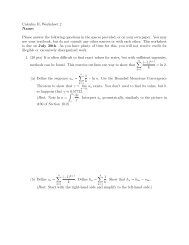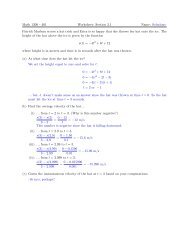4.6 worksheet 2
4.6 worksheet 2
4.6 worksheet 2
You also want an ePaper? Increase the reach of your titles
YUMPU automatically turns print PDFs into web optimized ePapers that Google loves.
Math 1300 <strong>4.6</strong> Rates and Related Rates (part 2) Name: Solutions3. A car is traveling north toward an intersection at a rate of 60 mph while a truck is travelingeast away from the intersection at a rate of 50 mph. Find the rate of change of the distancebetween the car and truck when the car is 3 miles south of the intersection and the truck is4 miles east of the intersection.xtruck →y↑carzdxdt= 50 miles/hrdydt= −60 miles/hrx 2 + y 2 = z 2When x = 4 and y = 3, we have z = √ 9 + 16 = 5 miles.Differentiating the equation above gives2x dx dy dz+ 2y = 2zdt dt dtdzdt = x dxdt + y dydtz=(4 mi)(50 mi/hr) + (3 mi)(−60 mi/hr)5 mi= 4 miles/hr.The distance between them is increasing at 4 miles/hr.
Math 1300 <strong>4.6</strong> Rates and Related Rates (part 2) Name: Solutions4. A rectangle of length l and width w has a constant area of 1200 in 2 . The side lengths arechanging while keeping the area the same. Suppose that at a particular instant the length isincreasing at 6 in/min and the width is decreasing at 2 in/min.(a) Find the dimensions of the rectangle at this instant.1200 = lw 0 = dldt w + ldw dtdldt = 6 in/mindwdt= −2 in/min1200/w = l 0 = 6w − 2l0 = 6w − 2(1200/w)6w 2 = 2400w 2 = 400w = 20 inchesl = 1200/20 = 60 inches(b) At this same instant, is the length of the diagonal increasing or decreasing? At what rate?D 2 = l 2 + w 22D dDdt = 2ldl dw+ 2wdt dtdDdt = l dldt + w dwdtDWhen l = 60 and w = 20, D = √ 60 2 + 20 2 = √ 3600 + 400 = √ 4000 = 20 √ 10 inches.dDdt=(60 in)(6 in/min) + (20 in)(−2 in/min)20 √ 10 in= 32020 √ 10in/min ≈ 5.06 in/min.The length of the diagonal is increasing at approximately 5.06 inches per minute.
Math 1300 <strong>4.6</strong> Rates and Related Rates (part 2) Name: Solutions5. An FBI agent with a powerful spyglass is located in a boat anchored 0.4 km offshore. Agangster under surveillance is walking along the shore. Assuming the shoreline is straightand that the gangster is walking at the rate of 2 km/hr, how fast must the FBI agent rotatethe spyglass to track the gangster when the gangster is 1 km from the point on the shorenearest to the boat? (In other words, find dθ/dt.)xgangster →0.4 kmθFBItan θ = x0.4sec 2 θ dθdt = 1 dx0.4 dt = 2.5dx dtdxdt = 2 km/hrWhen x = 1, we have tan θ = 1/0.4 and θ = arctan(1/0.4) = arctan(2.5)Useful trig identity: 1 + tan 2 ∗ = sec 2 ∗ for any value of ∗.dθdt=2.5dxdtsec 2 θ ==2.5(2 km/hr)sec 2 (arctan(2.5))51 + tan 2 (arctan(2.5)) = 51 + (2.5) 2 = 57.25 = 2029 radians/hr.


